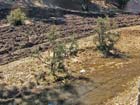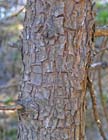
A tree 5 m tall, at the type locality, type variety [C.J. Earle, 2007.02.10].

Saplings growing at the type locality, type variety [C.J. Earle, 2007.02.10].

Branchlet, at the type locality, type variety [C.J. Earle, 2007.02.10].

Detail of foliage, type variety [C.J. Earle, 2007.02.10].

Sapling displaying epicormic juvenile foliage; at the type locality, type variety [C.J. Earle, 2007.02.10].

Bark on a 5 cm diameter stem, type variety [C.J. Earle, 2007.02.10].

Conservation Status

Juniperus blancoi
Martínez 1946
Common names
Táscate, blanco juniper (Zanoni and Adams 1979). For var. huehuentensis, huehue juniper or subalpine blanco juniper (Adams et al. 2006).
Taxonomic notes
This species and J. scopulorum, which are known to hybridize, are the only Mexican representatives of the smooth-leaf-margined junipers, Section Sabina (Adams et al. 2006, Adams et al. 2020). Type: Durango: El Salto: Arroyo de Peñuelas (Zanoni and Adams 1979). The type for var. mucronata is near Maicoba, Sonora, elev. 1180 m (Adams 2000). The type for var. huehuentensis is the summit of Cerro Huehuento, S of Huachichiles, Durango (Adams et al. 2006).
Farjon (2005) provides an argument discussing this taxon along with J. scopulorum and J. mucronata Adams (2000). He concludes it is doubtful that J. mucronata is distinct at the species rank and treats it as J. blancoi var. mucronata (R.P. Adams) Farjon. Data are really not sufficient to discriminate the two possibilities. Adams (2000) shows that blancoi and mucronata have highly disjunct ranges, substantially different terpene makeups, and slightly different morphology (heartwood color and presence/absence of mucronate leaf tips). The RAPD data presented by Adams (2000) distinguish blancoi and mucronata and indicate that they are distinct from J. scopulorum, but RAPD data alone must be treated with caution, and the differences identified do not necessarily support discrimination at the species rank. Resolution of the issue will require further genetic studies and/or more information on the vicariance process that established the disjunct modern populations. Meanwhile, I accept Farjon's taxonomy.
Adams et al. (2006) described J. blancoi Mart. var. huehuentensis R.P. Adams, S. González et M. González Elizondo. The variety occurs in a high mountain area; it is shrubby rather than erect, but grows with erect individuals of J. deppeana var. robusta, suggesting that the shrubby growth form is not simply due to foliage desiccation (the usual cause of alpine timberlines). Adams et al. (2006) also present a cladogram based on RAPD data for the type variety, varieties mucronata and huehuentensis, and J. scopulorum. These data indicate that var. huehuentensis is more similar to the type variety than is var. mucronata, raising the prospect that the latter taxon could be called subsp. mucronata although the combination has not been published. Var. huehuentensis appears to be sufficiently distinct from the type to warrant recognition; details are provided below.
Description
Evergreen, dioecious, shrubby tree 8-10(-15) m tall and 50 cm diameter. Bark smooth, soon exfoliating in small flakes, on larger stems fissured, rough, exfoliating in thin strips; red-brown or purple, turning grey. Branches spreading or ascending, forming a pyramidal crown that becomes broad or irregular in older trees. Ultimate branchlets lax, 4-25 × 0.8-1.3 mm, quadrangular, covered with scale leaves. Leaves decussate, imbricate, 1.3-2 × 0.7-1 mm, free, obtuse or apiculate, margins (hyaline-)entire, glands conspicuous, large, usually inactive; leaves grey-green to yellow-green. Seed cones terminal on short (3-6 mm) branchlets, green maturing in 1-2 years to a glaucous purple-red, dark blue or tan, subglobose to reniform or bilobed, 5-7 × 5-9 mm, interior soft-pulpy, seeds 1-2(-5) per cone, 3-5 × 2-4 mm, grooved and ridged with small resin pits near base, light brown with a darker hilum (Farjon 2005).
Var. mucronata differs from the type variety in that the leaf tips are mucronate rather than acute, and the heartwood is bright purple rather than purplish brown (Adams 2000).
Var. huehuentensis differs from the type variety in having a shrubby-prostrate habit, and in having the female cones attached to the lower sides of planate branchlets (Adams et al. 2006).
Distribution and Ecology
Mexico: Chihuahua, Durango, México, Michoacán, Sonora, and Tlaxcala (Adams 2000, Adams et al. 2006).
The type variety is known from Durango, México, Michoacán, and Tlaxcala. The México and Michoacán occurrences may have dispersed from cultivated trees, and a reported collection from Sonora has since been attributed to J. scopulorum (Adams et al. 2006). It occurs at about 1100-2900 m elevation in dry piñon woodland and along streambeds in pine-oak-juniper forest (Farjon 2005, Zanoni and Adams 1979). Hardy to Zone 8 (cold hardiness limit between -12.1°C and -6.7°C) (Bannister and Neuner 2001).
Var. mucronata is only known from the Maicoba/Yecora area near the Sonora/Chihuahua border (a conifer hotspot; see also Pinus yecorensis), where it occurs on slopes 30-60 m above the Maicoba River and neighboring streams, growing on basalt with Hesperocyparis lusitanica, Juniperus deppeana and Quercus spp. (Adams 2000).
Var. huehuentensis is only known from the area around the summit of Cerro Huehuento, S of Huachichiles, Durango, where it is found on bedrock and very thin soils at 3150-3270 m elevation (Adams et al. 2006).
Remarkable Specimens
No data as of 2023.03.03.
Ethnobotany
Observations
Although generally a rare species, the type variety is locally common in the vicinity of El Salto, Durango. See "Distribution and Ecology" for where to find var. mucronata.
Remarks
Citations
Adams, R.P. 2000. Systematics of smooth leaf margin Juniperus of the western hemisphere based on leaf essential oils and RAPD DNA finger printing. Biochemical Systematics and Ecology 28:149-162.
Adams, R.P., M.S. González Elizondo, M. González Elizondo, and E. Slinkman. 2006. DNA fingerprinting and terpenoid analysis of Juniperus blancoi var. huehuentensis (Cupressaceae), a new subalpine variety from Durango, Mexico. Biochemical Systematics and Ecology 34: 205-211.
Adams, R. P., M. Socorro González-Elizondo and George M. Ferguson. 2020a. Allopatric hybridization and introgression between Juniperus scopulorum Sarg. and Juniperus blancoi Mart. in northern Mexico: Unidirectional gene flow. Phytologia 102: 14-26.
Martínez. 1946. Anal. Inst. Biol. México 17:73-74.
See also
R.P. Adams' web site, juniperus.org.
The species account at Threatened Conifers of the World.
Farjon (2005) provides a detailed account, with illustrations.






